The cost of convicting young people
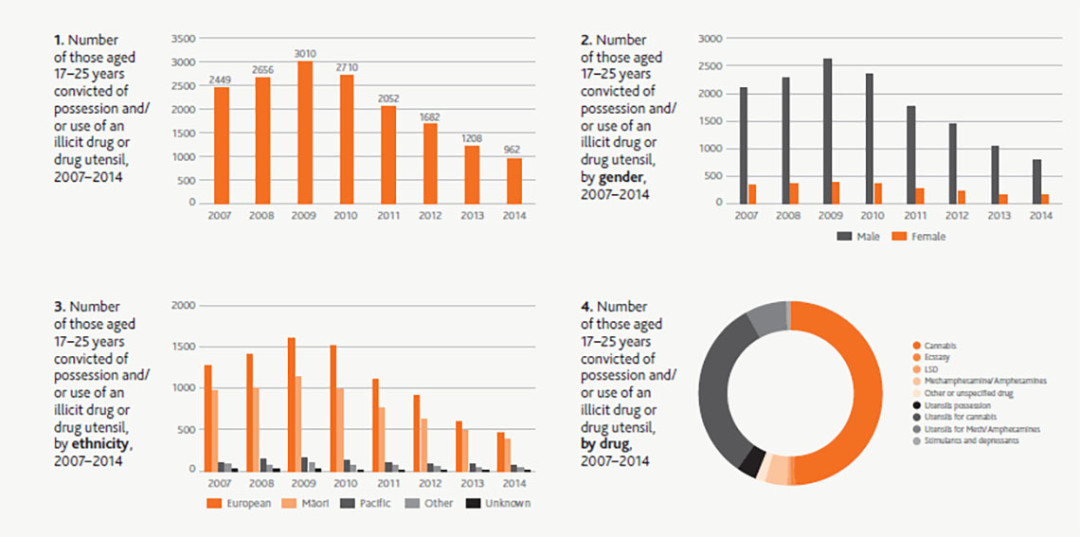
Our criminal justice approach under the Misuse of Drugs Act comes at a high cost to all involved, even just in terms of wasted tax dollars, but it is particularly younger people who bear the brunt of these costs.
Ministry of Justice figures indicate that, from 2007–2014, 16,729 young people between the ages of 17 and 25 were convicted of the relatively minor offence of possession and/or use of an illicit drug or drug utensil. That’s approaching half (40 percent) of all people convicted of those offences.
About 10 percent of those young people received prison sentences at an average length of 65 days. Department of Corrections figures indicate the average cost per day of imprisonment over this period was around $250 – that’s $16,250 per young person. With 1,777 young people receiving prison sentences for this sort of possession and/or use, we reach a total imprisonment-only cost of around $29 million.
If we consider the costs of all people receiving prison sentences for these minor drug offences over 2007–2014 – 5,039 people with an average sentence of 69 days – we reach the staggering figure of $87 million. And that does not include Police, court or probation costs.
Is this a good use of public funds?
Not only is this situation expensive, it causes social harms, particularly for young people. Convictions and imprisonment narrow opportunities, making it harder to get an education, employment, credit and travel, and it exposes youth to a negative environment. This damages life chances at a time when young brains and identities are forming.
Youth drug use rates
Young people higher drug use rate puts them in contact with the criminal justice system. The last Ministry of Health New Zealand Alcohol and Drug Use Survey 2007/08 found prevalence of using any drugs in the past year peaked in the 18–24 year age group. Over one-third of New Zealanders in this age group had used drugs in the past year (38.1 percent of males, 29.8 percent of females). Of those aged 25–35, around a quarter used drugs, dropping to just over a tenth of those aged 35–44.
Past-year cannabis use was also highest among youth (15–24 years) according to the New Zealand Health Survey into Cannabis Use 2012/13. About one in four (24 percent) of this age group had used cannabis in the past year.
Youth convictions
Encouragingly, trends have been very positive over the last five years, with convictions of young people for minor drug offences having dropped by two thirds from a peak of 3,010 in 2009 to 962 in 2014. However, we still convicted an average of 2,091 young people per year over 2007–2014.
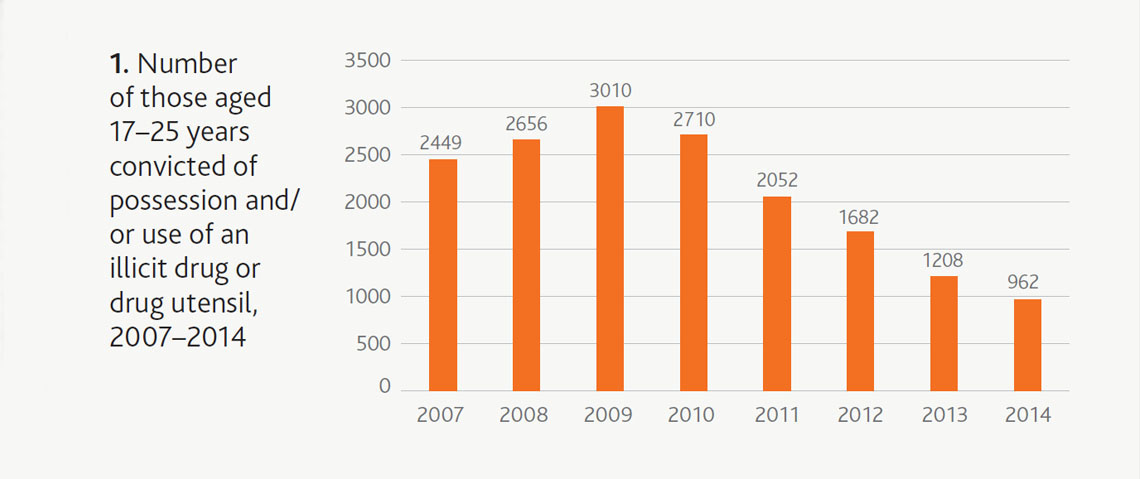
Declining numbers since 2009 of youth convictions for possession and/or use - 1. Number of those aged 17–25 years convicted of possession and/or use of an illicit drug or drug utensil, 2007–2014
Ethnicity and gender are important factors in these convictions, with significantly more males and Māori being convicted. Young males made up 86 percent of convictions.
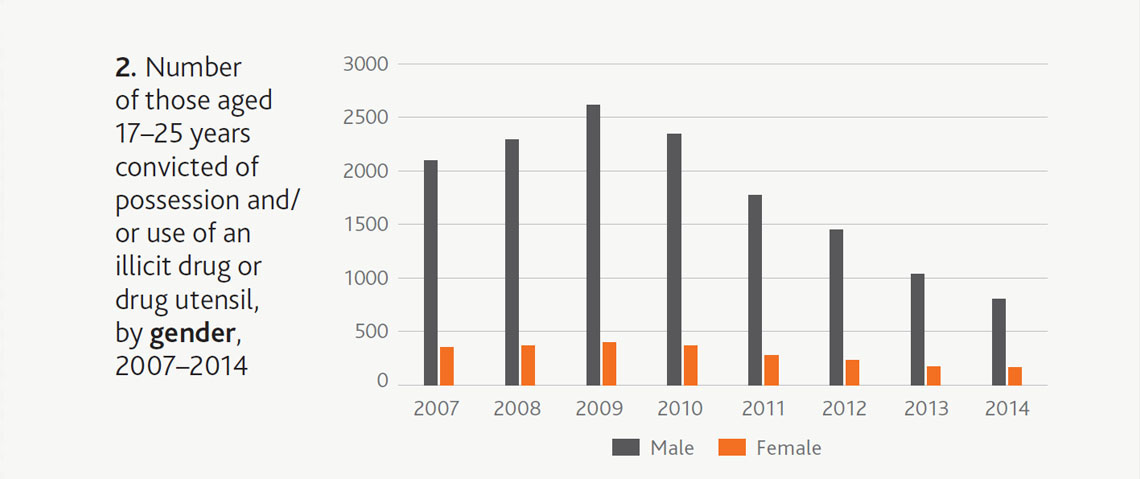
17–25 year-olds convicted by gender - 2. Number of those aged 17–25 years convicted of possession and/or use of an illicit drug or drug utensil, by gender, 2007–2014
Māori young people are over-represented in these figures, making up 38 percent of those convicted for minor drug offences over 2007–2014.
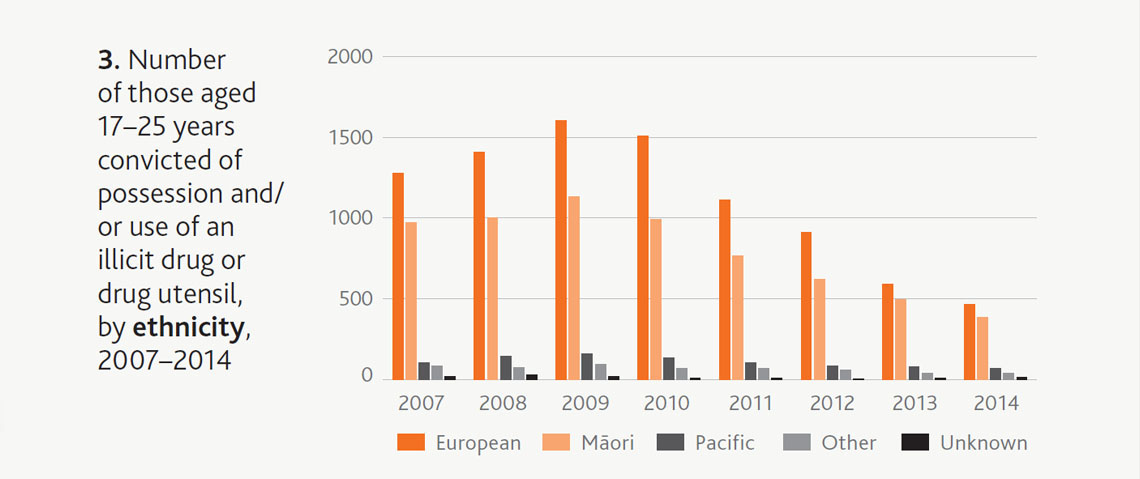
17–25 year-olds convicted by ethnicity - 3. Number of those aged 17–25 years convicted of possession and/or use of an illicit drug or drug utensil, by ethnicity, 2007–2014
Cannabis is overwhelmingly the drug most young people are convicted for. Offences for cannabis and cannabis utensils possession/use made up 82 percent of minor convictions. Methamphetamine or amphetamine offences account for 11 percent of convictions, with all other drug/utensil offences accounting for the remaining 7 percent.
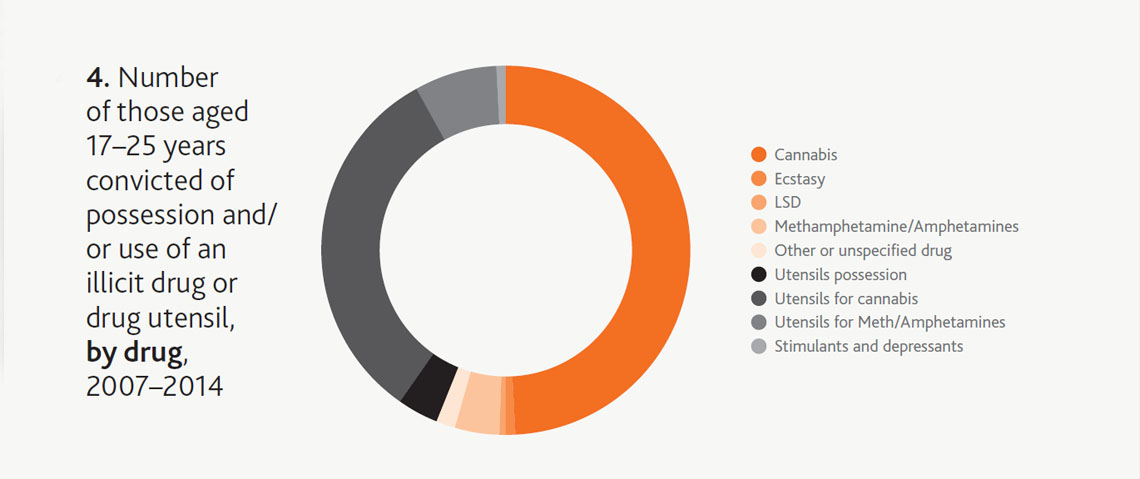
17–25 year-olds convicted by drug or utensil. Most cannabis. 2nd, much less, Meth/Amphetamines - 4. Number of those aged 17–25 years convicted of possession and/or use of an illicit drug or drug utensil, by drug, 2007–2014
There were also five young people under 17 years of age sentenced to imprisonment for possession and/or use of an illicit drug or drug utensil from 2007–2014. Their average sentence was 42 days.
Prison sentences don’t relate to drug class
Interesting anomalies emerge when we look at average prison sentences given for different drug types. These do not all align with what we might expect, given the respective classes of these drugs (i.e. A, B or C) under the Misuse of Drugs Act.
BZP (Class C) and ecstasy (Class B) offences received the longest prison sentences (as seen on the right). Cocaine, heroin and LSD offences received shorter sentences, despite all being Class A drugs. Factors other than drug classification and associated drug harm are obviously relevant in these decisions.
Imprisonment costs
Imprisoning our young people is expensive. With the average cost of imprisoning someone over 2007–2014 at $250 per day, we spent around $3.6 million each year over 2007–2014 imprisoning our young people.
| Age group | ||
|---|---|---|
| Under 17 | 17–25 | |
| Numbers imprisoned | 5 | 1,777 |
| Mean prison sentence (days) | 42 | 65 |
| Cost per person | $10,500 | $16,250 |
| Total cost | $52,500 | $28,876,250 |
The costs of convictions
16,729: young people convicted for minor drug offences from 2007–2014.
$29 million: spent imprisoning young people 17–25 for minor drug offences from 2007–2014.
$16,250: spent per person imprisoning young people for minor drug offences from 2007–2014.
Source: Ministry of Justice (2015). Response to Official Information Act request. Ref. 54731.
Recent news

Reflections from the 2024 UN Commission on Narcotic Drugs
Executive Director Sarah Helm reflects on this year's global drug conference
What can we learn from Australia’s free naloxone scheme?
As harm reduction advocates in Aotearoa push for better naloxone access, we look for lessons across the ditch.

A new approach to reporting on drug data
We've launched a new tool to help you find the latest drug data and changed how we report throughout the year.

